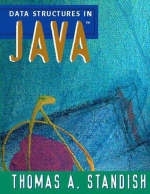
Data Structures in Java
Pearson (Verlag)
978-0-201-30564-7 (ISBN)
- Titel ist leider vergriffen;
keine Neuauflage - Artikel merken
Using Java 1.1, this book teaches the fundamentals of data structures and algorithms. With this exciting new language, Tim Standish takes a fresh look at the subject matter. New challenges arise any time a new language is used, and the author meets these challenges. For example, although Java is a language without explicit pointers, this book offers pointer diagrams to help students visualize, reason about, and understand this major Data Structures topic. Standish's clear presentation helps readers tie the many concepts of data structures together with recurring themes. Central ideas-such as modularity, levels of abstraction, efficiency, and tradeoffs-serve as integrators in the book in order to tie the material together conceptually and to reveal its underlying unity and interrelationships.
Thomas A. Standish is the chairman of computer science at the University of California, Irvine. In 1990-91, he became the fourth winner of University of California Irvine's Distinguished Faculty Lectureship for Teaching, the campus' highest distinction for teaching excellence. He has also been a co-winner of his department's best-teacher award, chosen by the popular vote of University of California Irvine undergraduate computer science students. 020130564XAB04062001
(Each chapter, except for Chapter 1, begin with Introduction and Motivation.)
1. Preparing for the Journey.
Where Are We Going?
Blending Mathematics, Science, and Engineering.
The Search for Enduring Principles in Computer Science.
Principles of Software System Structure.
Efficiency and Tradeoffs.
Software Engineering Principles.
Our Approach to Mathematics.
Some Notes on Programming Notation.
Preview of Coming Attractions.
2. Introduction to Object-Oriented Programming.
A Rectangle Drawing Applet.
The DrawShapes Applet.
Drawing Some Conclusions.
3. Linked Data Representations.
What are Pointers? The Basic Intuition.
Using Java’s Implicit Pointers — The Rudiments.
Pointer Diagramming Notation.
Linear Linked Lists.
Other Linked Data Structures.
4. Introduction to Recursion.
Thinking Recursively.
Common Pitfall — Infinite Regresses.
A Recursive Algorithm with Exponential Running Time.
5. Modularity and Data Abstraction.
Priority Queues — An Abstract Data Type.
Two Implementations for Priority Queues.
Plugging in New Kinds of Objects into Priority Queues.
Modularity and Information Hiding in Program Design.
6. Linear Data Structures — Stacks and Queues.
Some Background on Stacks.
ADTs for Stacks and Queues.
Using the Stack ADT to Check for Balanced Parentheses.
Using the Stack ADT to Evaluate Postfix Expressions.
Implementing the Stack ADT.
How Java Implements Recursive Method Calls Using Stacks.
Implementations of the Queue ADT.
More Queue Applications.
7. Lists, Strings, and Dynamic Memory Allocation.
Lists.
Generalized Lists.
Applications of Generalized Lists.
Strings.
Dynamic Memory Allocation.
8. Trees and Graphs.
Trees — Basic Concepts and Terminology.
Binary Trees.
A Sequential Binary Tree Representation.
An Application — Heaps and Priority Queues.
Traversing Binary Trees.
Binary Search Trees.
AVL Trees and Their Performance.
Two-Three Trees.
Tries.
An Application — Huffman Codes.
Graphs — Basic Concepts and Terminology.
Graph Representations.
Graph Searching.
Topological Ordering.
9. Hashing and the Table ADT.
The Table ADT.
Introduction to Hashing by Simple Examples.
Collisions, Load Factors, and Clusters.
Algorithms for Hashing by Open Addressing.
Choosing a Hash Function.
Comparison of Searching Methods Using the Table ADT.
10. Sorting.
Laying Some Groundwork.
Priority Queue Sorting Methods.
Divide-and-Conquer Methods.
Methods That Insert Keys and Keep Them Sorted.
O(n) Methods — Address Calculation Sorting.
Other Methods.
Comparison and Perspective.
Appendix A - A Review of Some Basic Java Features.
Appendix B - The Language of Efficiency.
Appendix C - Software Engineering Concepts. 020130564XT04062001
| Erscheint lt. Verlag | 3.9.1997 |
|---|---|
| Sprache | englisch |
| Maße | 214 x 242 mm |
| Gewicht | 1140 g |
| Themenwelt | Informatik ► Programmiersprachen / -werkzeuge ► Java |
| Mathematik / Informatik ► Informatik ► Software Entwicklung | |
| Informatik ► Theorie / Studium ► Algorithmen | |
| Mathematik / Informatik ► Informatik ► Web / Internet | |
| ISBN-10 | 0-201-30564-X / 020130564X |
| ISBN-13 | 978-0-201-30564-7 / 9780201305647 |
| Zustand | Neuware |
| Haben Sie eine Frage zum Produkt? |
aus dem Bereich


